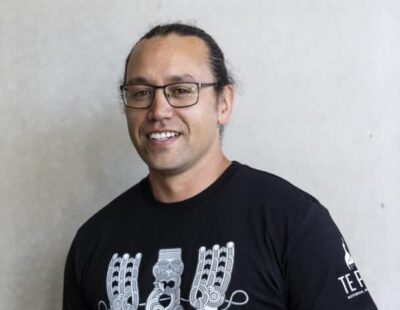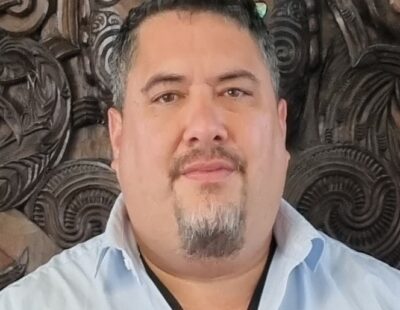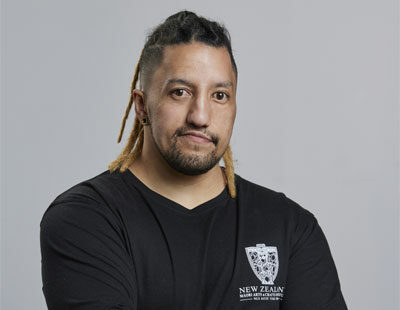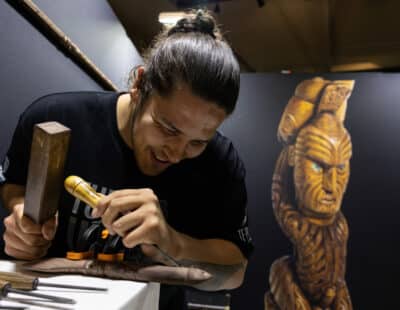Nau mai, haere mai ki Te Puia. Please check-in 15 minutes prior to your scheduled tour departure time.
About Te Wānanga Whakairo
“Ehara i a te rākau te whakaaro, kei ā te Tohunga tārai i te rākau te whakaaro – It is a carver, not the wood that has the understanding – If you forget your ancestors, you too are forgotten”
Since the first intake at Te Wānanga Whakairo, many young Māori from iwi (tribes) throughout New Zealand have been taught the Māori practice of wood carving under the expert guidance of master carvers who were once trainees at the school.
In 1967, seven carving apprentices were selected from throughout the country to train under master carver Hone Te Kauru Taiapa – a student of the first Wānanga Whakairo. Part of that 1967 group are present day New Zealand Māori Arts and Crafts Institute master carvers, Clive Fugill.
The school has been located in Te Whakarewarewa Valley since 16 January 1967, but it was initially established after legislation was passed in 1926 to preserve Māori arts and crafts, under the auspices of prominent Māori politician and lawyer Sir Apirana Ngata.
Many of the prominent wharenui (meeting houses) throughout New Zealand were carved by the men who were part of the first Wānanga Whakairo intake in 1927. Today’s graduates continue to build and restore wharenui throughout the country.
Course Information
NZMACI is mandated to train Māori from iwi (tribes) across New Zealand. Applicants for this school must be male, over 18 years of age and of Māori descent.
A maximum of five tauira (students) are selected each year.
This tohu (qualification) is for three years and is 40 hours per week, 47 weeks of the year.
Through the New Zealand Māori Arts and Crafts Institute Act 1963 (History) the Institute has the ability to award tohu to any person having special training in Māori arts, crafts or culture. The ability to independently recognise and confer qualifications remains a unique attribute of this organisation to this day.
Study Programme
During their study, the school’s carvers have the opportunity to be involved in major Kaupapa (initiatives) on-site, throughout New Zealand and overseas. The outcome is two-pronged – it fulfills NZMACI’s cultural perpetuation, protection and promotion mandate and exposes students to environments which help them see first-hand how knowledge, history, and ideas are manifested through material culture.
Students are taught:
- The techniques and skills required to transmit Māori concepts and kōrero (narratives) through carving and to create different taonga Māori (treasures)
- Materials used in traditional carving as well as practice in drawing and painting
- How to produce carving for each of the eight known tribal styles
- How to design and manufacture a Pātuki, TekoTeko and long and short hand weapons
- About waka functions, spirituality, design and manufacture
- The historical and spiritual significance of Taonga and manufacture including Taonga puuoro (Māori instruments)
- The historical and spiritual significance of customary practices used by tūpuna (ancestors)
- Functions and manufacture of whare
- How to select logs and the appropriate ceremonies to accompany this selection
Meet The Tutors

Grant Marunui
Tumu (Head of Whakairo Rākau) Te Arawa, RangitāneHohepa enrolled in the 1995 intake at Te Wānanga Whakairo o Whakaturia where he trained under the guiadance of Tony Kapua. During that time he, along with his classmates, were also fortunate to receive guidance from the Late Tuti Tukaokao. In 1996 Hohepa trained with Te Wānanga Whakairo o Aotearoa Rotorua under the tuteledge of Ruihana Phillips and in the latter James Te Kuiti Stewart. Hohepa completed the program in 1999. In 2003 Hohepa was fortunate to train further under former graduates Conrad Anaru and Mike Matchitt until 2005 where he applied at The New Zealand Māori Arts and Crafts Institute and was accepted. Hohepa completed his training under the guidance of Master Carver Albert Te Pou in 2009. Hohepa stayed on as a weekend Kaimahi until 2011,then transferred to Te Wānanga o Aotearoa Te Maunga,Kura Toi BMVA. He also worked with WINTEC as an External Assessor until 2022. Hohepa has returned to The New Zealand Māori Arts and Crafts Institute now as a Pouako.
Haami is a Pouako for Te Whare Whakairo (tutor at The National Wood Carving School). Haami graduated with the 39th intake to the school and has contributed to many projects during his time as a student as well as a member of staff.
Selected projects:
- 2013: Te Mahau: Ko Te Matatini (stage front) 30 metre wide mahau for Te Matatini – a biennial national kapa haka (Māori performing arts)
- 2017: Pou Maumahara intended for Belgium
- 2017: Poupou for the new NZMACI school entrance
- 2019: Waka Maumahara – Ngā Puna o Waiōrea kura
The installation of the pou, which form part of the Whakarewarewa Forest Development Project, provides the ability to share the whakapapa, genealogical histories of Ngā Hapū e Toru o Ngāti Whakaue, the tribal grouping who are the tangata whenua of Tītokorangi.
Lenny’s passion for Toi Māori originated from his experiences through mau rakau. In hindsight, Lenny realized how fortunate he was to be a part of these wānanga. It was the first time Lenny had been exposed to traditional moko. Following these experiences, Lenny was reprimanded many times for drawing in class but continued regardless. By the chance, the Arts Captain for his school enrolled Lenny onto a carving course through Te Wānanga o Raukawa. This ignited the fire within Lenny to carve and he has never looked back since.
I'm considering study at The National Wood Carving School
Applicants must be of Māori descent, male and 18 years old or over. You must also be able to demonstrate a competency in Māori art and/or design and have an ability and willingness to interpret and understand the theory component of this qualification. To maintain the standard and quality of our graduates, places are strictly limited.
Applications are now closed.


